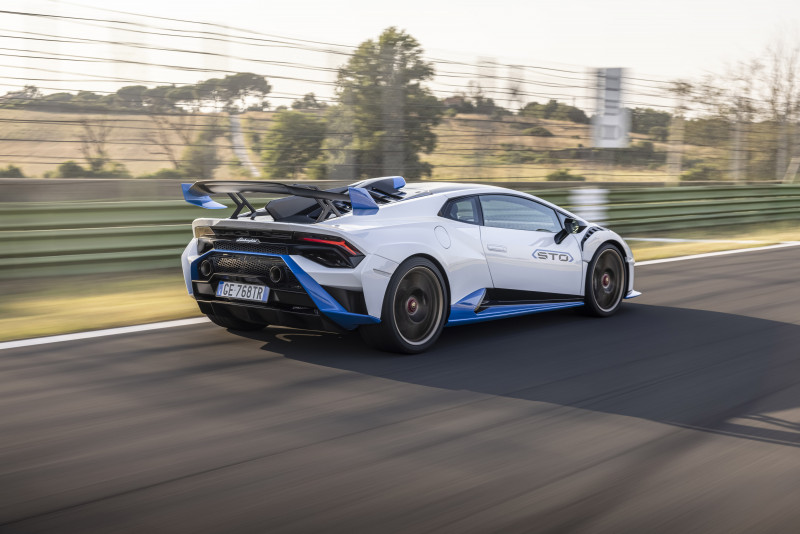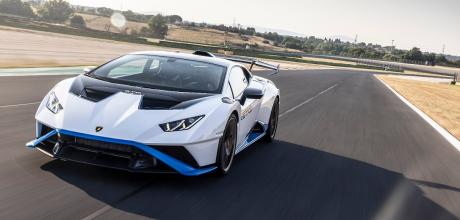2022 Lamborghini Huracán STO LB724
Is this Lambo’s best ever car? We find out. Much more than a Huracán with a bodykit and lairy paint, the new STO finally realises the potential that we all hoped was there, as we discover at Vallelunga circuit. Story by Dan Trent.
Loud & Proud HURACÁN STO BEST LAMBO EVER?
As we swelter in the mid-summer heat at Vallelunga circuit during the launch of the new Huracán STO, Lamborghini’s technical boss Maurizio Reggiani is in reflective mood: “I always said that the one thing missing from Lamborghini was a car for track days – and now we have it.” I first met Reggiani at the static unveiling of the original Huracán LP610-4 at Sant’Agata back in 2014 and, having attended launches for pretty much every variant between then and now, it feels like we’ve been on something of a journey together as the car has evolved under his watch.

It’s a journey that has seen Lamborghini transition from a brand for show-offs to one that now competes against its direct rivals on track and, like them, leverages motorsport success for credibility in its roadgoing product. It’s not a game that Lamborghini has traditionally felt the need to play. But it’s something that changed with the Huracán, with both ‘gentleman driver’ one-make Super Trofeo championships and entry to frontline GT3 racing against the likes of Porsche, Ferrari, Aston Martin, McLaren, Mercedes-AMG and the rest. Early signs that Reggiani and his team were keen to leverage this – and rattle a few cages – then came with a startling Nürburgring lap time for the Huracán Performante, the most extreme roadgoing Huracán yet (previous to the new STO, at any rate).
I vividly recall being on the Porsche stand at the Geneva show where this feat was announced publicly and overhearing a conversation between two senior Porsche development bosses that revealed much about who within the wider VW group was ‘supposed’ to be chasing ’Ring lap times. Having declared in blunt terms his doubts that the Huracán was capable of a 6min 52sec lap, my Porsche man concluded with the revealing line: “And anyway, it is my f***ing Nürburgring!” This as then-boss Stefano Domenicali and Reggiani stood beaming like naughty schoolboys beside the Performante on the adjacent show stand, doubtless aware of the internal political storm they’d just whipped up.
The Performante was Reggiani’s answer to some of the criticisms of the original LP610-4 Huracán – that was just a little too safe in its handling and character. Where even an average driver could make a contemporary Ferrari dance on the throttle, and purists loved McLaren’s Lotus-style feel, the Huracán looked and sounded great but was about as exciting to drive as the mainstream products from its Audi parent company. With its trick ‘aero vectoring’ variable downforce and increased power, the Performante was a step in the right direction, but it was still all-wheel drive and far from being a Pista, GT3 RS or McLaren Longtail in its focus. In contrast, this new STO is all racer and all about lap times. But it’s also, perhaps, the best-handling Huracán yet. The fundamentals remain the same as with all Huracáns, which is to say the familiar – and fabulous – 5.2-litre V10 and its very vocal demand for 8000rpm before it will give you its full 640hp. No torque-filling turbos or hybrid assistance here, and though it’s down on the numbers compared with more recent rivals, it never disappoints in its responses, or the charismatic way it delivers them.
Like the Super Trofeo and GT3 racers, the STO is rear-wheel drive rather than all-wheel drive, and also carries the rear-wheel steering introduced on the Huracán Evo, as well as revised springs, anti-roll bars and settings for the variable magnetorheological dampers. There is – finally – a steering setup that’s fast and fixed rate. Reggiani’s apologetic shrug suggests he knew all along that the previous options of a slow-racked passive set-up or gloopy variable system were both significant chinks in the Huracán’s dynamic armour.
Visually the STO makes a bigger statement still. The bodywork is now allcarbon bar the roof and doors. The front end is a one-piece clamshell while the rear quarters are totally reshaped and widened to accommodate broader track and new aero, while also reducing the frontal area to cut drag. A roof snorkel directs air through the engine bay for better cooling, while a vertical shark fin helps both lateral stability and airflow over the three-position rear wing. Downforce and aero efficiency are also massively improved over the Performante, with as much as 420kg at 280km/h and the ability to adjust the aerodynamic balance according to taste. Uprated CCM-R brakes and new Bridgestone road-legal track tyres are other important contributors to both consistency and linearity of response to satisfy serious drivers.
But do serious drivers really buy Lamborghinis? It takes just one run through the fearsome fifth-gear downhill right-left at Vallelunga to appreciate how all this adds up, and why they might now want to. Where the original LP610-4 was vague and inconsistent in its turn-in, there’s sufficient weight to the STO’s wheel that you feel the tread blocks biting into the hot tarmac. Thankfully the damping is there with the support to balance the car as the loads build through the chassis, the speeds sufficient that the aero has a meaningful stabilising effect and you’re happy picking up the throttle smartly with no fear of unsettling the car. This is a Huracán with all the good bits – the glorious noise, the lag-free throttle response, the visual drama – amped up and all the disappointing gloop in the controls eradicated.
The maximum downforce setting applied to the launch cars means a rearward aero balance. While that’s good for stability, it takes a little off the front end, meaning understeer is still apparent on turn-in. Even taking that into account, you have more faith in the front end than any other Huracán that’s gone before and the confidence to bring the throttle in early, the linearity of the response meaning there’s no sudden turbocharged or electrified squirt overwhelming the rear tyres. Rather, the STO just feels beautifully balanced and way more communicative than previous Huracáns. That’s much more confidence-inspiring, on the basis that the balance of power has now shifted back to the driver and away from the black boxes. Just as the one-make Super Trofeo cars are designed simultaneously to flatter and thrill the gentleman racer, the STO does the same, proving both easy to drive quickly but no less exciting for that. This focus, underscored with the stuff Lamborghini already does so well (like noise, drama and – yes – a sense of fun) is something of a revelation.
With three consecutive 24-hour victories at Daytona it’s little wonder that Lamborghini has chosen Vallelunga circuit to demonstrate proof of concept, sharing with us a lap time of 1min 48.86sec on the Bridgestone track tyres against the 1min 46.4sec of a slickshod GT3 race car. To add more context, the STO is three seconds faster than the Performante by the same measure. Given Porsche has recently re-established its ownership of Nordschleife lap records, I ask Reggiani if he’s planning any trips back to the Eifel mountains in the near future, to which he grins and changes the subject.
Such capabilities are all very well for bragging rights, and great fun for journalists invited to razz the STO around a track for a day on Lamborghini’s tyre budget. But will any of this actually matter to the people buying a car that, even by the standards of the brand, looks pretty wild for the public road? And will the people who buy (and track) the Porsche 911 GT3s that Reggiani says are the benchmark in this sector really feel inclined to do the same with a Lamborghini that some may say looks like it took a wrong turn through a Mansory showroom?
That will be down to the customers, of course. But with the validation of race success, and the sense this is a Huracán you could hammer all day on track without any fear of it flagging, it can back up those looks with some real ability. Let’s hope owners can find tracks with noise limits accommodating enough for them to prove it.
Reshaped aero ensures epic downforce, while track-spec tyres deliver handling feel aplenty.
TECHNICAL SPECIFICATIONS 2022 Lamborghini Huracán STO
- ENGINE: 5204cc naturally aspirated V10
- MAX POWER: 640bhp at 8000rpm
- MAX TORQUE: 565Nm at 6500rpm
- TRANSMISSION: 7-speed dual-clutch, rear-wheel drive
- BRAKES: CCM-R discs 390x34mm front, 360x28mm rear
- TYRES: 245/30 R20 front, 305/30 R20 rear
- DIMENSIONS: 4549mm (L), 1945mm (W), 1220mm (H)
- WEIGHT: 1339kg
- MAX SPEED: 193mph
- 0-62MPH: 3.0sec
- PRICE: £260,012
“ Finally, here is an amped-up Huracán with all the disappointing gloop in the controls eradicated ”


